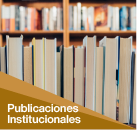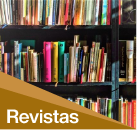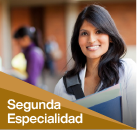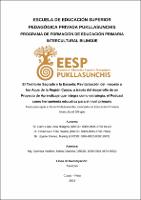El Territorio Sagrado y la Escuela: Revitalización del respeto a los Apus de la Región Cusco, a través del desarrollo de un Proyecto de Aprendizaje que integra como estrategia, el Podcast como herramienta educativa para el nivel primario
Fecha
2024-04-23Autor
Cairo Lope, Ana Milagros
Chillahuani Ttito, Walter
Ugarte Gomez, Mariely
Nivel de Acceso
Acceso AbiertoMetadatos
Mostrar el registro completo del ítemResumen
El presente estudio ofrece un panorama acerca del tema, territorio sagrado. Territorio es donde vivimos, compartimos, la relación entre el hombre y la naturaleza para vivir en armonía, practicando los valores como el respeto, empatía, para mantener el equilibrio entre nosotros. En esta investigación queremos mostrar el valor que se debe tener a los Apus de la región. Los Apus son muy importantes en la vida de la comunidad para armonizar y vivir en reciprocidad con los animales, las plantas, porque ellos son los que nos cuidan. Los Apus tienen espíritus, se manifiestan o aparecen mediante un animal, también suelen aparecer en los sueños de una persona con la finalidad de transmitir un mensaje, sobre algún problema que pueda pasar en la comunidad. Ellos son personas como nosotros que sienten, que hablan, ellos cuando no les tienes fe, no los respetas, demuestran su molestia dándonos enfermedades u ocasionando accidentes. Este estudio se ocupa de los Apus, pero también nos permitió ver los conocimientos que se encuentran en el territorio sagrado. El territorio sagrado no solamente son los Apus, son todos aquellos espacios sagrados que se encuentran en el mundo. Sin embargo, existen personas que desconocen el valor que tienen los Apus dentro de la comunidad. Hoy en día, las nuevas generaciones no tienen el interés de conocer su territorio sagrado por la influencia de la tecnología y la globalización, a ellos solo les importa tener lo material, a la madre tierra la ven como un recurso. Por otra parte, existen sectas religiosas que afectan en el conocimiento de estos saberes ya que no son partícipes en las actividades que organiza la comunidad. Desde nuestras prácticas preprofesionales observamos que las escuelas no incluyen los saberes locales. Hay docentes que no son capacitados para trabajar desde la interculturalidad, que solo son contratados y no están formados desde la educación E.I.B. Con este estudio planteamos elaborar un proyecto de aprendizaje que nos permita incluir estos saberes, teniendo en cuenta el calendario cívico y comunal, para trabajar equilibradamente desde las dos miradas. Nosotros hemos realizado un proyecto de aprendizaje de los Apus para incluir los saberes de la comunidad. Aparte de eso, este trabajo de investigación ayudó a fortalecer nuestra identidad como investigadores. Abstract The present study offers an overview about the subject, sacred territory is where we live, share, the relationship between man and nature to live in harmony, practicing values such as respect, empathy, to maintain balance between us. In this research we want to show the value that should be had to the Apus of the region. The Apus are very important in the life of the community to harmonize and live in reciprocity with animals, plants, because he is the one who takes care of them. The Apus have spirits, they manifest or appear through an animal, on the other hand, they also usually appear in the dreams of a person in order to transmit a message, about some problem that may happen in the community. They are people like us who feel that they speak, they when you do not have faith in them, you do not respect them they show their annoyance by giving us diseases, causing accidents, etc. In addition, in this study it allowed us to see the knowledge found in the sacred territory. The sacred territory is not only the Apus, it is all those sacred spaces that are found in the world. However, there are people who are unaware of the value of Apus within the community. Today the new generations do not have the interest of knowing their sacred territory due to the influence of technology and globalization, they only care about having the material, mother earth sees it as a resource, also the sects religions affects the knowledge of this knowledge since they are not participants in the activities organized by the community. On the other hand, from our pre-professional practices we observe that schools do not include local knowledge. There are teachers who are not trained to work from interculturality, who are only hired and are not trained from EIB education. For this reason, we had the opportunity to teach and investigate from their context of students and parents, this helps to achieve significant learning from their mother tongue and student experiences, just as teachers become aware to teach and learn from their experiences of students. Also, following the objective of our research, this study is prepared by chapters. With this study we propose to develop a learning project where it allows us to include this knowledge taking into account the civic and communal calendar to work in a balanced way from both perspectives. We have carried out a learning project of the Apus to include the knowledge of the community, wise men, students and they are part of the construction of their learning. A teacher must work from the heart to promote the respect that should be had to the Apus, manifesting and sharing this knowledge to the children from the heart of their people. Other than that, this research work. It helped us a lot to strengthen our identity as researchers. Apart from being researchers we realized that since childhood in school we did not know about the value they had to the hills, but we did live in relationship, but that relationship was without knowing, we were innocent we saw our parents who made haywarikuy and phukurikuy (give / blow) but we have never asked them why they did it, Also no one has encouraged us neither the teachers nor the school, we lived in our world. In addition, this research aimed to achieve an educational material, the podcast, an audio, through the collection of transcribed testimonies and their translations from Quechua to Spanish. Therefore, this material will help students to identify more with their context and have respect. Thus, without knowing what they were a living being, we receive knowledge from the classification of biotic and abiotic beings. Biotics are all those who have life that can be reproduced, but Abiotics are considered inert something that can not be reproduced as stones, Apu, water, but for the Andean world they are the most sacred, everything has a reason for its existence in this life and all fulfill a function. Keywords: Bilingual Intercultural Education, Sacred Territory, Podcast, Intercultural Educational Material. Pisi rimayllapi willasayki Kay yachayqa huk qhawariyta qun temamanta, sagrado territorioqa maypichus tiyasqanchik, rakinakunchik, runawan pachamamawan tupanakuyninku hukllapi kawsanapaq, chaninchaykunata ruwaspa respeto, empatía, ñuqanchikpura equilibrio kananpaq. Kay investigacionpiqa qawachiyta munanchikmi chay regionpa Apus nisqakunaman ima valorta quna kasqanmanta. Apukunaqa ancha chaninchasqam kanku llaqtapa kawsayninpi, uywakunawan, yurakunawan kuskanchanakunankupaq, hukwan kuska kawsanankupaq, paymi paykunata qhawaq. Apukunaqa espiritukunayoqmi kanku, paykunaqa huk uywawanmi rikuchikunku otaq rikhurimunku, huk ladomantaq, aswantaqa runaq musquyninpi rikhurimunku huk willakuyta willanankupaq, llaqtapi huk sasachakuymanta. Paykunaqa ñuqanchikhina runakunam, rimasqankuta sienteq, mana iñiyniyuq kaspayki, mana respetaspa, piñakuyninkuta qawachispanku unquykunata quwaspanchik, accidentekunata ruwaspa, hukkunatapas. Chaymantapas, kay estudiopin permitiwaranchis sagrado territoriopi tarikuq yachaykunata rikunanchispaq. Sagrado territorioqa manan Apusllachu, aswanpas llapan chay sagrado espaciokuna kay pachapi tarisqa. Shinapash kanmi runakuna, ayllu ukupi Apus chanimanta mana yachakkuna. Kunan pachaqa musuq miraykunaqa manam munankuchu sagrado territorionkuta yachayta tecnologiapa, globalización nisqapa influencianrayku, paykunaqa materialniyuq kayllatam preocupakunku, Pachamamataqa recurso hinam qawanku, secta religiosakunapas kay yachaypa yachaynintam afectan mana kasqankumantapacha ayllullaktapak rurashka ruraykunapi tantanakukkuna. Huk ladumantaq, manaraq profesional ruwasqaykumanta qhawariyku yachaywasikunapi mana llaqta yachaykunata churasqankuta. Kanmi yachachiqkuna mana interculturalidadmanta llamkanankupaq yachachisqa, contratasqalla, mana EIB educaciónmanta yachachisqa. Kay raykun, yachakuqkunapa, tayta mamakunapa contextonmanta yachachinapaq, investiganapaq ima oportunidadta tarirqayku, kayqa yanapanmi mama siminkumanta, yachakuqkunapa experiencianmanta ima hatun yachaykunata aypanapaq, imaynam yachachiqkunapas yachayninkumanta yachachinankupaq, yachanankupaqpas yachanku hina.of the yachakukkuna. Chaynallataqmi, investigacionniykupa munasqanman hina, kay estudioqa capitulokunaman hina wakichisqa kachkan. Kay yachaywanmi yuyaykuyku huk yachay proyecto ruwayta, chaywanmi kay yachaykunata churasunman calendario cívico y comunitario nisqapi qhawarispa, iskaynin qhawariymanta equilibrasqa llank’anapaq. Apus yachay proyectota ruwarqayku, llaqtapa yachayninkunata, yachaqkuna, yachakuqkunapa yachayninkunata churanaykupaq hinaspa paykunapas yachayninku ruwaypi kachkanku. Yachachiqmi sunqumanta llamk’anan Apukunaman yupaychayta kallpachananpaq, kay yachaykunata llaqtankupa sunqunmanta qari warmakunaman, warmi warmakunaman riqsichispa, willakuspa. Chaymanta wakpi kay investigación llamk’aynin. Anchatam yanapawarqaku investigador hina identidadniyku kallpanchanaykupaq. Investigador kasqaykumanta hawaqa, repararqayku escuelapi huch’uyllaraq kasqaykumantapachan mana yacharqaykuchu urqukunaq valorninta, ichaqa huk relacionpin kawsarqayku, ichaqa chay relacionqa mana yachaspallan karqan, mana huchayoqmi karqayku, tayta mamaykuta rikurqayku chay haywarikuywan chay phukurikuywan (quy/sopla) ichaqa manan hayk’aqpas tApurqaykuchu imarayku chayta ruwarqanku, hinallataq mana pipas kallpachawarqankuchu ni yachachiqkunapas nitaq yachaywasipas, kay pachanchispi kawsarqayku. Hinaspapas, kay investigacionqa munarqa material educativo, podcast, huk audio, chayayta munaspa, testimonios transcritos nisqakunata huñuspa, quechuamanta kastilla simiman tikrasqankuta ruwaspa. Chayraykum kay yachachikuyqa estudiantekunata yanapanqa contexto nisqankuwan aswanta riqsikunankupaq hinaspa respetoyuq kanankupaq. Chaynapim, ima kawsaq kasqankuta mana yachaspaqa, biótico hinaspa abiótico nisqakunapa clasificacionninmanta yachaykunata chaskinchik. Bióticos nisqakunaqa llapanmi kanku mirayta atiq kawsayniyuq, ichaqa Abióticos nisqakunataqa inerte nisqatan qhawarinku rumikuna hina, Apu hina, unu hina mana mirachiy atikuq, ichaqa andino pachapaqqa aswan ch’uyami, tukuy imapas tukuy imapaqmi razonniyoq.kaypi kayninku kawsaypas llapankutaqmi huk ruwayta hunt’anku.







